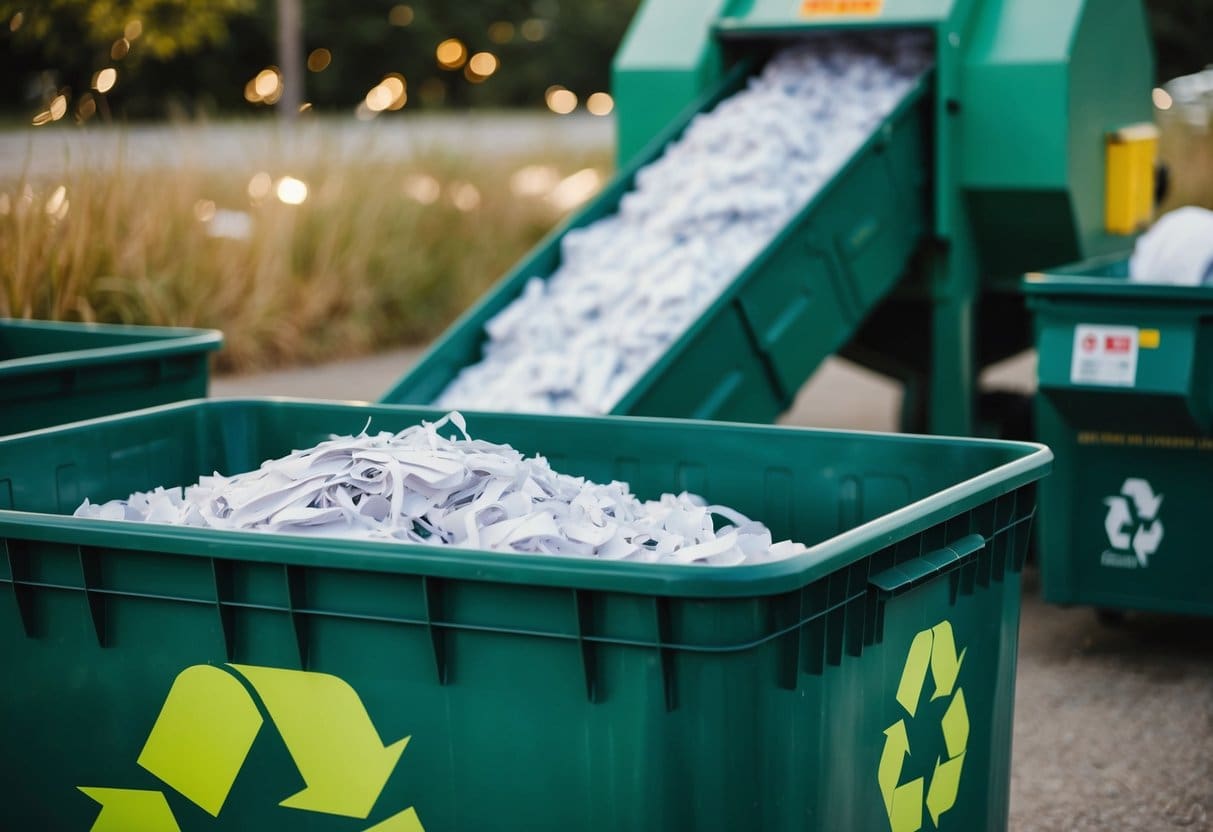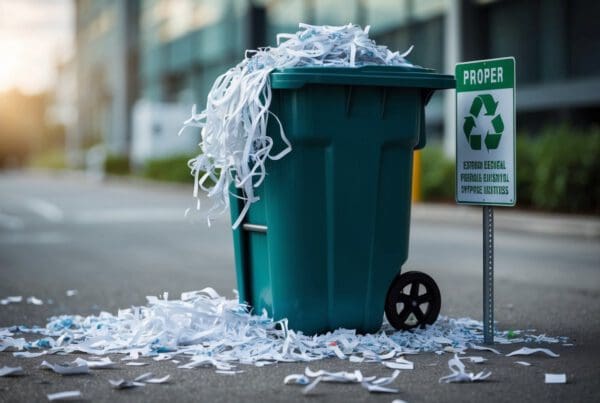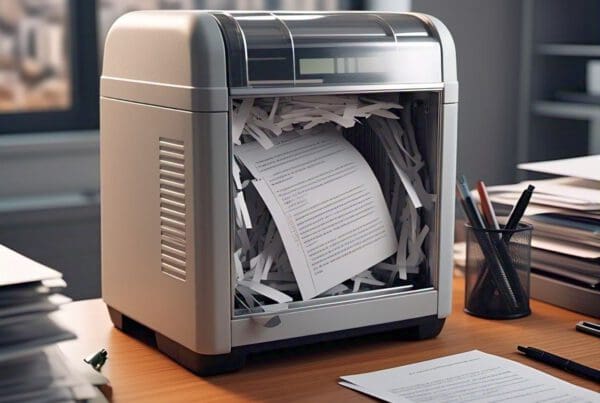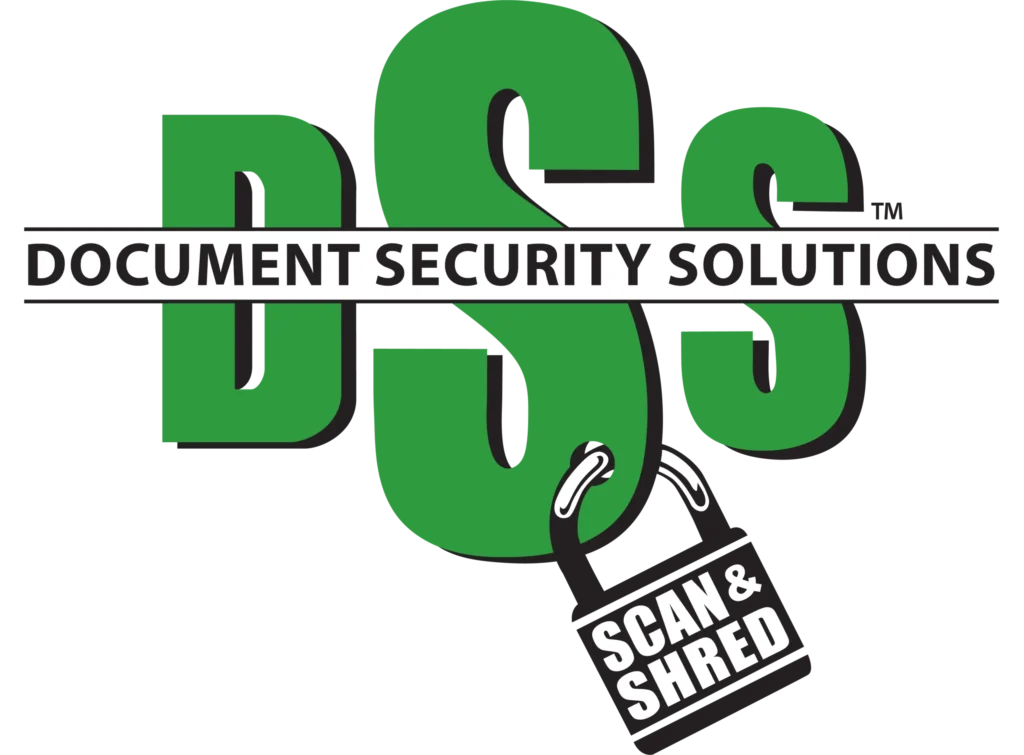Understanding Paper Shredding and Recycling
Paper shredding and recycling are crucial for ensuring confidentiality and environmental sustainability. Shredded paper impacts recycling processes, requiring careful handling to maximize its recyclability and environmental benefits.
Basics of Paper Shredding
Paper shredding reduces documents to shreds, protecting sensitive information. Shredding creates small, irregular pieces, making it difficult to reconstruct the original document. This process is important for privacy, especially in businesses handling confidential data.
Shredded paper comes in different sizes based on the shredder used. This variability affects how easily the paper can be recycled. Smaller shreds might mix with other recyclables, complicating the sorting process. To recycle effectively, it’s crucial to know how your local facility handles shredded paper.
The Recycling Process for Paper Shreds
Recycling shredded paper can be challenging. We need to understand how shredded paper fits into the recycling process. Mismatched sizes can clog machinery, making the process less efficient. It’s important to bag shredded paper separately before taking it to recycling centers.
Not all facilities accept shredded paper due to these challenges. Check with local recycling centers to see their specific requirements. These centers often have guidelines for preparing and delivering shredded material. Proper preparation increases the likelihood of successful recycling, boosting environmental benefits by reducing waste and saving resources.
Understanding these aspects helps us better manage paper waste.
Role of Local Recycling Centers

Local recycling centers play a crucial role in handling paper waste. They ensure that shredded paper is appropriately disposed of and processed. By maintaining efficient collection and sorting systems, we can help prevent contamination and ensure compliance with recycling guidelines.
Collection and Sorting Systems
Recycling centers provide a reliable system for collecting and sorting paper waste. We set up recycling bins in accessible locations, encouraging community members to participate in recycling efforts. The collection process is designed to be efficient, allowing us to gather large volumes of paper quickly.
In our facilities, we have advanced sorting machines that accurately separate paper from other materials. Proper sorting is essential to maintain the quality of recyclables. Our staff is trained to manually check the waste, ensuring no contaminants are mixed in.
Organized sorting systems help maximize the amount of paper that can be recycled, reducing waste in landfills. We also offer shredding services, providing a secure way to dispose of sensitive documents correctly.
Compliance and Contamination Prevention
Adhering to recycling regulations is vital for maintaining efficient operations. We educate the community about what materials can be recycled and provide clear instructions on how to prepare waste for disposal. Compliance with recycling rules helps in reducing contamination levels.
Contamination is a significant challenge that recycling centers face. Incorrect items mixed with paper recyclables can cause entire batches to be sent to landfills. Our teams work diligently to monitor and minimize contamination, ensuring high-quality recycling outputs.
We encourage the use of designated bins for specific materials and provide educational materials to help the community understand the importance of proper sorting. Together, we strive to make recycling more effective and sustainable.
Sustainability and Environmental Impact

Recycling centers play a crucial role in reducing waste and promoting eco-friendly practices. By focusing on paper shredding disposal, we contribute to sustainability and minimize environmental harm.
Minimizing Landfill Contribution
Reducing the load on landfills is vital. When we shred paper and send it to recycling centers, less waste goes to landfills. This helps limit the space needed for waste storage and prevents harmful leakage into the soil.
Landfills generate methane, a greenhouse gas. By recycling paper, we lessen methane production. This supports a cleaner environment and a sustainable future. Our efforts in recycling ensure that waste is managed responsibly and reduces dependency on landfills.
Promoting Eco-Friendly Solutions
Recycling centers provide eco-friendly alternatives. When paper is recycled instead of discarded, it can be reused in new products. This process conserves resources and energy. It reduces the need for raw materials, like trees, and protects natural habitats.
The environmental impact from paper production is also decreased. By choosing recycling, we support soil health and prevent deforestation. Our consideration extends beyond waste reduction, fostering sustainable and eco-conscious communities. Recycling centers thus serve as a bridge to a more sustainable future.
Data Security and Identity Protection
Local recycling centers play a vital role in protecting us from identity theft by offering secure shredding services. These centers handle sensitive information carefully, ensuring that confidential data is destroyed safely.
Sensitive Information Handling
We must understand the importance of handling sensitive information. Local recycling centers ensure that documents like medical records, personal details, and financial statements are kept safe during the shredding process. Using controlled access and secure facilities, they prevent unauthorized persons from accessing confidential information.
Different techniques are employed to make sure no data security breaches occur. For instance, specialized shredders create confetti-sized pieces, making it extremely hard to reconstruct a document. These measures are crucial for protecting our identities and avoiding data breaches.
Secure Shredding Services
Secure shredding services offer us a reliable way to destroy documents safely. These services are vital in ensuring that our private details remain confidential. Typically, recycling centers use high-capacity shredders that can handle large volumes of paper efficiently.
Some centers even offer on-site shredding, allowing us to witness document destruction for added security. This transparency helps build trust, assuring us that our information is handled properly. By providing certified document destruction, these services protect us from risks like identity theft, showcasing their significance in safeguarding our data.





